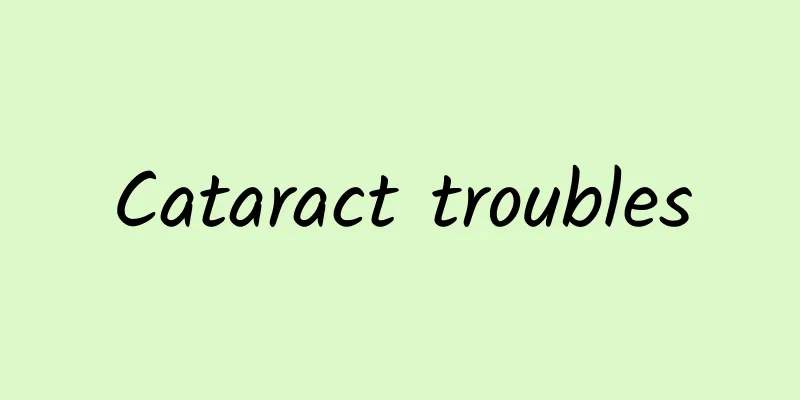Cataract troubles

|
What should I eat to prevent cataracts? In the ophthalmology ward, the most common surgery is cataract surgery. Many elderly people come for surgery, and their accompanying spouses and friends will ask the doctor to help them see if they have cataracts. The most common question is "What can I eat to avoid cataracts?" The cruel fact is: no matter what you eat, you will get cataracts! Cataracts are divided into many types according to different causes. Among them, senile cataracts are a natural process of human aging and are inevitable. As long as you live long enough, you will definitely get them. Just like hair turning white, although everyone's age is different, it will turn white sooner or later. (There are also people who never get white hair, such as those who die young) So, can people not get old? No! Can people not get cataracts? No! Why do people get senile cataracts? If our eyes are compared to a camera, then the lens is the lens of the camera, which plays the role of adjusting the focus. The opacity of the lens and the loss of vision caused by various reasons such as congenital defects, metabolic diseases, injury stimulation or natural aging are called cataracts. Senile cataracts are the most common acquired primary cataracts, which are related to the degenerative changes caused by the slow metabolism of the elderly and are more common in people over 40 years old. The incidence rate among people aged 50-60 is 60%-70%, and about 80% of people over 70 years old have lens opacity. There are many factors that affect senile cataracts. Metabolic decline caused by physiological aging, long-term regulatory tension, vascular sclerosis, malnutrition, radiation damage such as ultraviolet rays, and endocrine disorders can all cause physiological changes in the lens, making it unable to maintain its normal shape, losing transparency and gradually becoming turbid. What are the symptoms of senile cataracts? The main manifestation of senile cataract is decreased vision and eye fatigue. However, the degree of decreased vision is sometimes not completely consistent with the degree of lens opacity. This is because the location of lens opacity has a greater impact on vision. Generally speaking, the lens is composed of a nucleus, a cortex, and a layer of capsule on the outside. Among them, the opacity under the posterior capsule has the greatest impact on vision, especially the central opacity will cause decreased vision in the early stage, while the opacity of the peripheral cortex has almost no symptoms. Early nuclear opacity can cause myopia due to the increase in the refractive index of the nucleus. Some elderly people will find that reading books and newspapers is getting clearer and clearer, and they don’t even need reading glasses anymore. Don’t be too happy too soon. This is not rejuvenation, but the cataract is getting worse. In addition to decreased vision, some elderly patients also have symptoms of photophobia and diplopia. A patient once said that when he looked up, the crescent moon became a string of moons. In a few elderly people (especially those with hyperopia), the lens cortex may cause secondary glaucoma during the expansion period, resulting in increased intraocular pressure, sudden eye swelling, headache, nausea and vomiting. At this time, you should go to the hospital in time to reduce intraocular pressure to avoid irreversible optic nerve damage. (Don't delay seeing a doctor because it's difficult to register. You can directly register for an emergency number and go to the hospital at any time). Most elderly people have lens opacity that weakens the light entering their eyes, so they need brighter places to see things clearly. However, some cataract patients cannot see clearly in bright places and need to go to places with dim light to see. This is because the pupil will shrink when the light is particularly bright, and if the opacity is right in the center, it will be completely blocked. In the dark, the pupil will expand, and they can see things from the surrounding areas without opacity. Some elderly people do not have a significant decrease in vision during physical examinations, but they clearly feel that their vision quality is not as good as before in daily life. At this time, a contrast sensitivity test may be able to find the problem. Because even if the opacity of the lens has not affected the routine vision test, it has already caused the contrast sensitivity vision to decrease. It is like looking at flowers in the fog. Although you can still distinguish the appearance of the flowers, they are far less beautiful than those seen on a sunny day. It should be noted that the blurred vision of the elderly is not necessarily due to cataracts. It may simply be due to a decline in the ability to adjust, commonly known as "presbyopia", which makes reading increasingly blurry and even makes it difficult to see the TV. However, as long as you go to the hospital for an eye test and get a pair of suitable reading glasses, the problem can be solved. There are also some serious eye diseases, such as macular degeneration, retinal detachment, acute glaucoma attacks, etc., which may suddenly cause blurred vision. Therefore, if the elderly cannot see clearly, they should not assume that it is presbyopia or cataracts, but should go to the hospital for examination in time to avoid delaying treatment. Are there other types of cataracts besides senile cataracts? In addition to the most common age-related cataracts, there are many other causes of cataracts: 1. Congenital cataract: abnormal lens development due to genetic genes or damage during embryonic development, such as nutritional or metabolic disorders during pregnancy, viral infection in early pregnancy, alcoholism, excessive exposure to X-rays, etc., can cause fetal lens opacity. 2. Concurrent cataract: Other eye diseases that cause lens opacity become concurrent cataracts, such as iridocyclitis, high myopia, glaucoma, etc., which may cause local circulation disorders in the eye and lead to abnormal lens metabolism. 3. Secondary cataract: The opacity of the lens caused by systemic diseases is called secondary cataract. Any acute infectious disease that is not cured, such as typhoid fever, or wasting diseases such as anemia, nephritis, and even long-term malnutrition can cause secondary cataract. Among the people who are more common in secondary cataract are: diabetic patients, tetany patients, and myotonic muscular atrophy patients. What should I do if I have senile cataracts? There are many drugs for cataracts on the market, mainly in the following categories: 1. Auxiliary nutritional drugs (such as vitamins B, C, E, carotene, etc.). 2. Drugs related to the quinone theory (such as Catalin, Bai Nei Ting, etc.). 3. Antioxidant damage drugs (such as glutathione, taurine, etc.). 4. Aldose reductase inhibitors (such as Catalin, Phacolysion, etc.). 5. Traditional Chinese medicine (such as Qiju Dihuang Pills or Shihu Yeguang Pills, etc.). However, all drugs cannot cure or prevent the occurrence and development of cataracts, but can only slow down the progression of lens opacity. When cataract develops to the end, only surgery can restore vision. In the past, most surgeries used "extracapsular cataract extraction", which had a large incision and a long operation time. The timing of the operation required that the cataract "mature" before it could be performed, and the nucleus of the lens had to be hardened before a large incision could be made to fish it out. However, with the development of phacoemulsification technology, the progress of cataract surgery has been promoted. In recent years, "phacoemulsification of cataract" has been carried out in more and more hospitals. This new surgical method makes the incision smaller and smaller, and the incision can close by itself without stitches. Since the nucleus of the lens needs to be broken up with ultrasonic energy, if the cataract has been there for too long and the nucleus is too hard, it is possible that the ultrasound cannot break it up or a lot of energy is needed to break the nucleus, and a lot of energy will cause damage to other tissues of the eye, such as the cornea. Therefore, the timing of cataract surgery can be advanced now, and there is no need to wait until the cataract can no longer be seen before surgery. As long as you feel that the opacity of the lens affects the quality of life, you can have surgery. Is cataract surgery simple to perform and effective? Many people think that cataract surgery is a minor operation that will be completed in 20 minutes. In fact, cataract surgery is definitely a technical job and is not simple at all. As the saying goes: 10 minutes on stage, 10 years of hard work off stage. Most patients see immediate results after the operation, and their vision is restored to be better than when they were young (because cataract surgery can also solve the problem of myopia), but surgery has risks. Once endophthalmitis is infected after the operation, the eyeball may need to be removed. It is good enough to save the eye, and the vision is almost zero. Of course, the probability of endophthalmitis is very small. Isn't it possible to derail a train? So don't be too nervous when you need surgery. What is destined to happen will happen, and what is not destined to happen will not happen. Many elderly people complain after surgery: My neighbor can see everything after cataract surgery, why is my vision still bad? This depends on the individual. The eye is a whole. To see things, it depends not only on the lens, but also on the cornea, retina, vitreous body, etc. It's like a camera. If the lens is broken, we can replace it with a new one, but if the film is also broken, no matter how many lenses are replaced, we can't take good photos. Therefore, if the eyes are accompanied by other eye diseases in addition to lens opacity, especially retinal disease, even if a new lens is replaced, the vision will not improve to normal. Cataract surgery is not a cure-all. What's more regrettable is that due to the obstruction of the cloudy lens, the retina behind the lens may not be observed before the operation. Even if the shape can be vaguely seen, it is difficult to accurately evaluate its function. The elderly may be accompanied by age-related macular degeneration, which is often not discovered until after cataract surgery. Now there are more and more elderly people suffering from diabetes and hypertension. These diseases may cause retinal disease and affect vision. As the saying goes: The greater the hope, the greater the disappointment. Therefore, correctly understanding the risks and efficacy of cataract surgery will help you adjust your mentality, come to the hospital happily, and go home happily! What should the elderly pay attention to? Although there is no clear way to absolutely avoid senile cataracts, it is good to delay its onset. Later, later, and later... Maybe by the end of my life, I can still see! First, avoid stimulation to prevent aging, such as ultraviolet rays, infrared rays, sunlight, etc. Wear sunglasses for outdoor activities under strong light. Secondly, a person is a whole body. If you get a serious illness, all organs will be affected. Maintaining a healthy body, preventing and controlling diabetes, renal insufficiency, severe diarrhea, etc. are also very beneficial to protecting the eyes. Finally, medicine is three-point poison. If it is not necessary, try to use eye drops or take systemic medicine as little as possible to prevent the toxicity of drugs from affecting the lens, especially hormone drugs that are prone to cause cataracts. In short, good living habits, stay away from tobacco and alcohol, eat more vegetables and fruits to supplement various vitamins and trace elements, maintain balanced nutrition, drink more water and exercise more, and be in a good mood to stay away from diseases. People are a whole, and the key is balance. If any organ has problems, other organs will be affected. As the saying goes: everyone is well, then it is really good! A healthy lifestyle not only helps to delay the occurrence of cataracts, but is also essential for the elderly to prevent chronic diseases such as diabetes and hypertension! |
>>: Does electric mosquito repellent have safety risks? Don't make these mistakes when using it
Recommend
What kind of lotus root is better for cold lotus root slices?
We all know that lotus root is a very popular foo...
Can gynecological inflammation infect the ovaries?
When women develop gynecological inflammation, th...
Normal ferritin levels in 6-month-old pregnant women
During pregnancy, in order to ensure the physical...
What should girls do if they have less hair on their foreheads?
I believe many of my friends are familiar with ha...
Why is it that one breast is bigger than the other?
Many women will find that one of their breasts is...
What body type of woman is the most surprising in bed?
Lips are the body’s secret “sex weapon”. Accordin...
What are the taboos of ethnic minorities in Yunnan? Where are the amusement parks in Yunnan?
Ruili River and Daying River National Scenic Spot...
What are the causes of uterine bleeding in women?
Uterine bleeding is something that many people fe...
The dangers of low triglycerides in women
When you reach a certain age, you will have your ...
What causes heel pain in women?
We walk every day, and once there is a problem wi...
How to repair sagging breasts
Postpartum complications are very serious. Accord...
Does periodontitis only damage teeth? The truth is more complicated than you think
Periodontitis, as a common oral disease that is a...
The "sword" for myopia prevention and control - defocus lenses
Author: Zhang Wenjuan: The First Affiliated Hospi...
Abdominal pain three days after miscarriage
What is the reason for lower abdominal pain after...
Why do kidney beans get powdery mildew? What medicine can be used to treat powdery mildew on kidney beans?
Kidney beans are very common in our daily life. P...



![[Solar terms health care] Here is a guide to the grain in ear health care for you, follow it to avoid getting sick in summer](/upload/images/67f1f32f01c59.webp)





